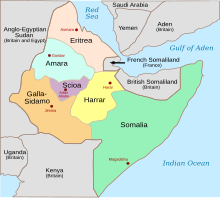
Back Districte Amhara Catalan Gobernación de Amara Spanish Governatorato di Amara Italian Amara (província) Portuguese Губернаторство Амхара Russian
| Amhara Governorate Governatorato di Amara | |||||||||
|---|---|---|---|---|---|---|---|---|---|
| Governorate of Italian East Africa | |||||||||
 Amhara (blue) within Italian East Africa | |||||||||
| Capital | Gondar | ||||||||
| Population | |||||||||
• | ca. 2,000,000 | ||||||||
| Government | |||||||||
| Governor | |||||||||
• 1936–1937 | Alessandro Pirzio Biroli | ||||||||
• 1937–1939 | Ottorino Mezzetti | ||||||||
• 1937–1941 | Luigi Frusci | ||||||||
• 1941 | Guglielmo Nasi | ||||||||
| Historical era | Interwar period World War II | ||||||||
• Created | 1 June 1936 | ||||||||
| 27 November 1941 | |||||||||
| |||||||||
Amhara Governorate was one of the six governorates of Italian East Africa. Its capital was Gondar. It was formed in 1936 from parts of the conquered Ethiopian Empire following the Second Italo-Ethiopian War. It had a population of more than two million inhabitants (In 1940 11,200 were Italians settlers, mostly in the capital Gondar). In November 1938 some territory of Amhara in the Scioa region was given to the neighboring Addis Abeba Governorate, enlarging it to the Scioa Governorate.
The region was a stronghold of fierce Ethiopian resistance against the Italians. By 1940, the last areas of guerrilla activity was around Lake Tana and southern Gojjam, under the leadership of the degiac Mengesha Gembere and Belay Zeleke.[1]
- ^ Barker 1968, pp. 281, 300.
